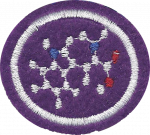Difference between revisions of "AY Honors/Biochemistry/Answer Key/es"
(Created page with "{{clear}}") |
(Created page with "{{clear}}") |
||
| Line 138: | Line 138: | ||
The citric acid cycle (also known as the Krebs Cycle after its discoverer '''Hans Adolf Krebs''') is a crucial metabolic pathway that takes the breakdown products from the food we eat (proteins, fats and sugars) and produces three NADH, one FADH2, and one GTP molecule. the NADH and FADH2 are fed into the oxidative phosphorylation (electron transport) pathway producing ATP the body's main energy storage molecule. NADH and FADH generate 2.5 and 1.5 ATP molecules respectively in oxidative phosphorylation. GTP can also be used to form an extra ATP. | The citric acid cycle (also known as the Krebs Cycle after its discoverer '''Hans Adolf Krebs''') is a crucial metabolic pathway that takes the breakdown products from the food we eat (proteins, fats and sugars) and produces three NADH, one FADH2, and one GTP molecule. the NADH and FADH2 are fed into the oxidative phosphorylation (electron transport) pathway producing ATP the body's main energy storage molecule. NADH and FADH generate 2.5 and 1.5 ATP molecules respectively in oxidative phosphorylation. GTP can also be used to form an extra ATP. | ||
| − | + | {{clear}} | |
| − | |||
| − | |||
| − | |||
| − | |||
<noinclude></noinclude> | <noinclude></noinclude> | ||
Revision as of 17:25, 15 February 2021
| Bioquímica | ||
|---|---|---|
| División Sudamericana
|
Destreza: 3 Año de introducción: 2012 |
|
Requisitos
1
1a
1b
1c
1d
1e
1f
1g
1h
1i
1j
1k
2
3
4
5
6
brain cells
7
Oxaloacetate is an intermediate in both these biochemical pathways, in the production of glucose from pyruvate and the Krebs Cycle . it is also involved in the urea cycle, the glyoxylate cycle, amino acid synthesis, and fatty acid synthesis.
8
The citric acid cycle (also known as the Krebs Cycle after its discoverer Hans Adolf Krebs) is a crucial metabolic pathway that takes the breakdown products from the food we eat (proteins, fats and sugars) and produces three NADH, one FADH2, and one GTP molecule. the NADH and FADH2 are fed into the oxidative phosphorylation (electron transport) pathway producing ATP the body's main energy storage molecule. NADH and FADH generate 2.5 and 1.5 ATP molecules respectively in oxidative phosphorylation. GTP can also be used to form an extra ATP.
9
10
11
The total energy gained from one (six-carbon) molecule of glucose in the citric acid cycle and oxidative phosphorylation equals about 30 ATP molecules. The number of ATP molecules derived from the same number of carbon atoms in a fatty acid chain is 40. So lipids are more efficient for energy storage.
12
13
Essential Amino Acids
There are amino acids that cannot be made by the human body. They only come from food. There are 9 types of Essential Amino Acids. They are isoleucine, leucine, histidine, lysine, methionine, phenylalanine, threonine, valine, tryptophan
Non-Essential Amino Acids
Our bodies make these amino acids. There are 4 types: asparagine, alanine, glutamic acid, aspartic acid.
14
15
Amino Acids forms proteins. They are organic compounds when combined that help build cells. When proteins from the Amino Acids break down they leave Amino Acids. The body uses the amino acids to break down food, grow, repair cells and skin cells. They can be stored and used for energy.
16
17
References
- Categoría: Tiene imagen de insignia
- Adventist Youth Honors Answer Book/Honors/es
- Adventist Youth Honors Answer Book/es
- Adventist Youth Honors Answer Book/Skill Level 3/es
- Categoría: Libro de respuestas de especialidades JA/Especialidades introducidas en 2012
- Categoría: Libro de Respuestas de Especialidades JA/División Sudamericana
- Adventist Youth Honors Answer Book/Health and Science/es
- Adventist Youth Honors Answer Book/Health and Science/Primary/es
- Adventist Youth Honors Answer Book/Stage 0/es
- Adventist Youth Honors Answer Book



